Engineering Mathematics: Complex Numbers, Boolean Algebra Assignment
VerifiedAdded on 2020/05/16
|16
|944
|457
Homework Assignment
AI Summary
This document presents a detailed solution to an Engineering Mathematics assignment, encompassing various core concepts. The assignment is divided into two parts, the first of which focuses on complex numbers, including operations in rectangular and polar forms, and their representation on Argand diagrams. It also covers calculations of current and phase in circuits, and vector analysis using the nose-to-tail method. The second part delves into topics such as error analysis, binary to decimal and hexadecimal conversions, and Boolean algebra, including the derivation of Boolean expressions from truth tables and switching circuits. The solution provides step-by-step calculations, diagrams, and references to relevant resources, offering a comprehensive guide for students studying engineering mathematics. The assignment covers a wide range of topics, including complex numbers, Boolean algebra, binary conversions, circuit analysis and error analysis.

Engineering Mathematics 1
ENGINEERING MATHEMATICS
by [NAME]
Course
Professor’s Name
Institution
Location of Institution
Date
ENGINEERING MATHEMATICS
by [NAME]
Course
Professor’s Name
Institution
Location of Institution
Date
Paraphrase This Document
Need a fresh take? Get an instant paraphrase of this document with our AI Paraphraser

Engineering Mathematics 2
Engineering mathematics
Part 1
Task 1
The following expression represents two complex numbers which are to be multiplied.
( A+ jB ) ( C− jD )
Carry out the operation working in rectangular form
Since A=6, B=8, C=2 and D=4 the complex numbers become (6+ j 8)( 2− j 4 )
Therefore, the operation becomes,
¿ 12− j24 + j 16−32( j2)
¿ 44− j 8
Polar form
e1= √ 62 +82 =10
θ1=tan−1 8
6 =53.43
z1=10 e53.43i
e2= √ 22 +42 =√20
θ2=tan−1 4
2 =63.43
z2= √20 e63.43i
Engineering mathematics
Part 1
Task 1
The following expression represents two complex numbers which are to be multiplied.
( A+ jB ) ( C− jD )
Carry out the operation working in rectangular form
Since A=6, B=8, C=2 and D=4 the complex numbers become (6+ j 8)( 2− j 4 )
Therefore, the operation becomes,
¿ 12− j24 + j 16−32( j2)
¿ 44− j 8
Polar form
e1= √ 62 +82 =10
θ1=tan−1 8
6 =53.43
z1=10 e53.43i
e2= √ 22 +42 =√20
θ2=tan−1 4
2 =63.43
z2= √20 e63.43i

Engineering Mathematics 3
44 e116.56 i
The above solution is equal to ¿ 44− j 8 therefore the two answers are similar. The solution can
be presented on an Argand diagram as shown below.
Task 2
The following expression represents two complex numbers which ae to be divided.
A+ jB
C− jD
Rectangular form
Since A=6, B=8, C=2 and D=4 the complex numbers become 6+ j8
2− j4
The first step is multiplying the complex number with the conjugate of the denominator as
follows;
6+ j8
2− j4 × 2+ j 4
2+ j 4 = 12+ j 24+ j16−32
4 +16
44 e116.56 i
The above solution is equal to ¿ 44− j 8 therefore the two answers are similar. The solution can
be presented on an Argand diagram as shown below.
Task 2
The following expression represents two complex numbers which ae to be divided.
A+ jB
C− jD
Rectangular form
Since A=6, B=8, C=2 and D=4 the complex numbers become 6+ j8
2− j4
The first step is multiplying the complex number with the conjugate of the denominator as
follows;
6+ j8
2− j4 × 2+ j 4
2+ j 4 = 12+ j 24+ j16−32
4 +16
⊘ This is a preview!⊘
Do you want full access?
Subscribe today to unlock all pages.

Trusted by 1+ million students worldwide
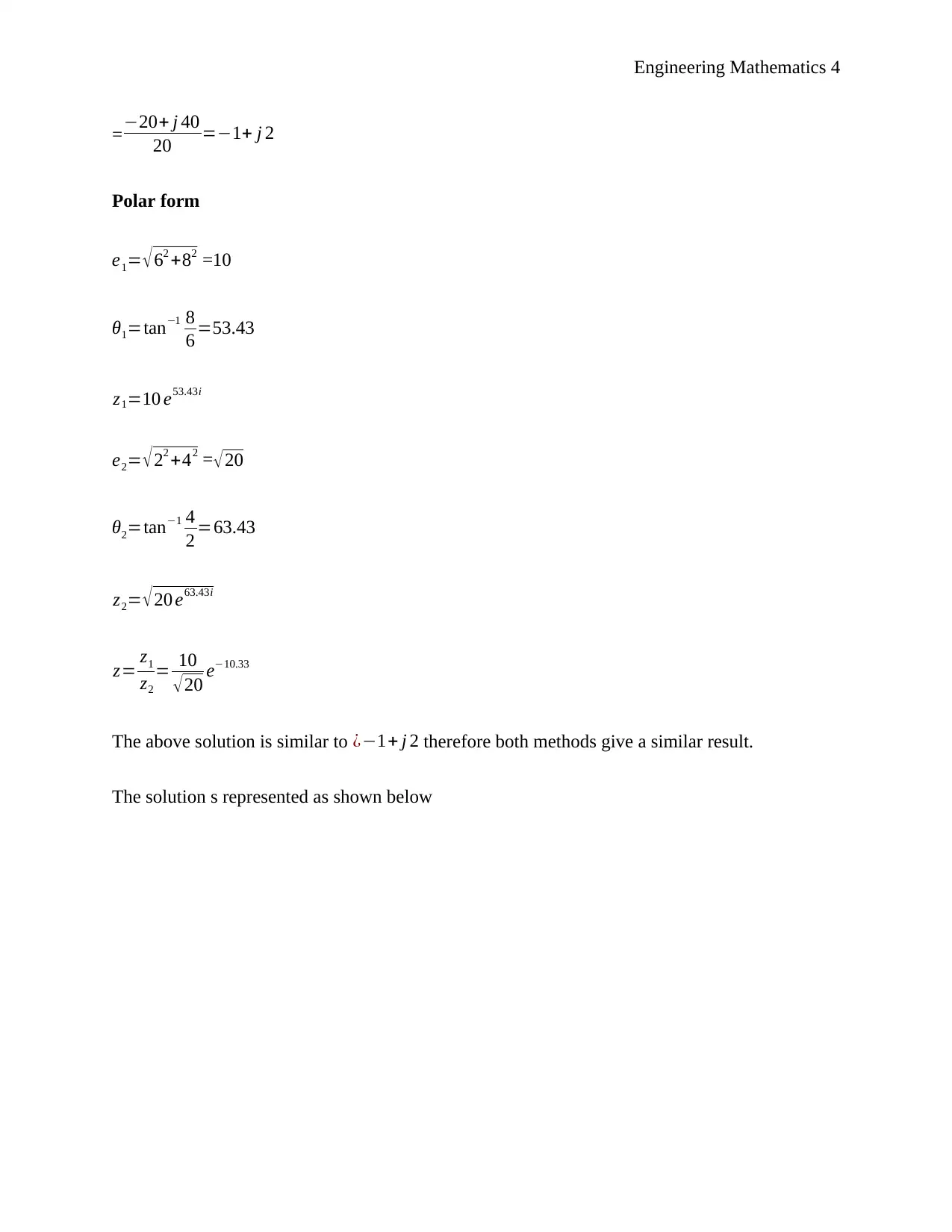
Engineering Mathematics 4
=−20+ j 40
20 =−1+ j 2
Polar form
e1= √ 62 +82 =10
θ1=tan−1 8
6 =53.43
z1=10 e53.43i
e2= √ 22 +42 =√20
θ2=tan−1 4
2 =63.43
z2= √20 e63.43i
z= z1
z2
= 10
√20 e−10.33
The above solution is similar to ¿−1+ j 2 therefore both methods give a similar result.
The solution s represented as shown below
=−20+ j 40
20 =−1+ j 2
Polar form
e1= √ 62 +82 =10
θ1=tan−1 8
6 =53.43
z1=10 e53.43i
e2= √ 22 +42 =√20
θ2=tan−1 4
2 =63.43
z2= √20 e63.43i
z= z1
z2
= 10
√20 e−10.33
The above solution is similar to ¿−1+ j 2 therefore both methods give a similar result.
The solution s represented as shown below
Paraphrase This Document
Need a fresh take? Get an instant paraphrase of this document with our AI Paraphraser
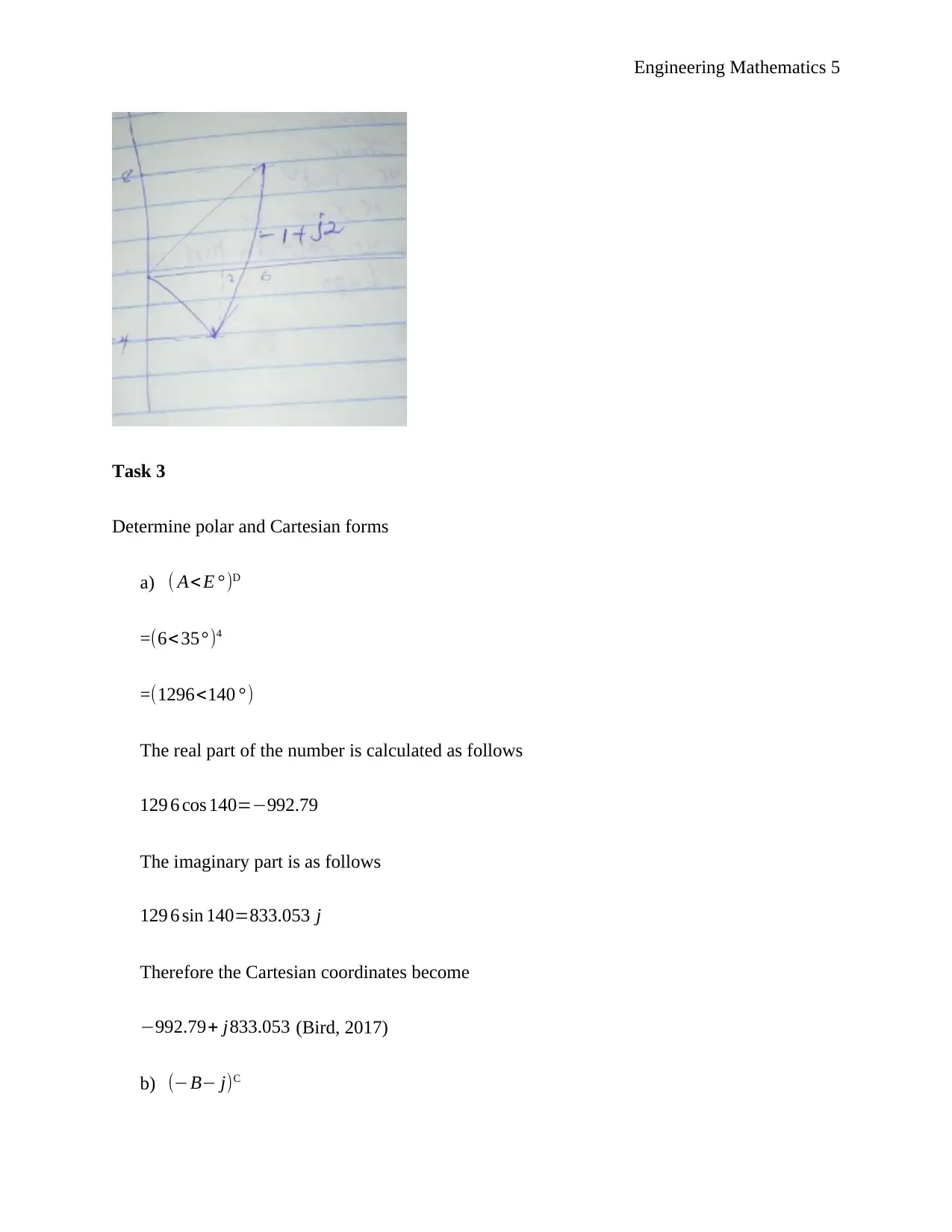
Engineering Mathematics 5
Task 3
Determine polar and Cartesian forms
a) ( A< E °)D
=(6<35°)4
=(1296<140 ° )
The real part of the number is calculated as follows
129 6 cos 140=−992.79
The imaginary part is as follows
129 6 sin 140=833.053 j
Therefore the Cartesian coordinates become
−992.79+ j833.053 (Bird, 2017)
b) (−B− j)C
Task 3
Determine polar and Cartesian forms
a) ( A< E °)D
=(6<35°)4
=(1296<140 ° )
The real part of the number is calculated as follows
129 6 cos 140=−992.79
The imaginary part is as follows
129 6 sin 140=833.053 j
Therefore the Cartesian coordinates become
−992.79+ j833.053 (Bird, 2017)
b) (−B− j)C
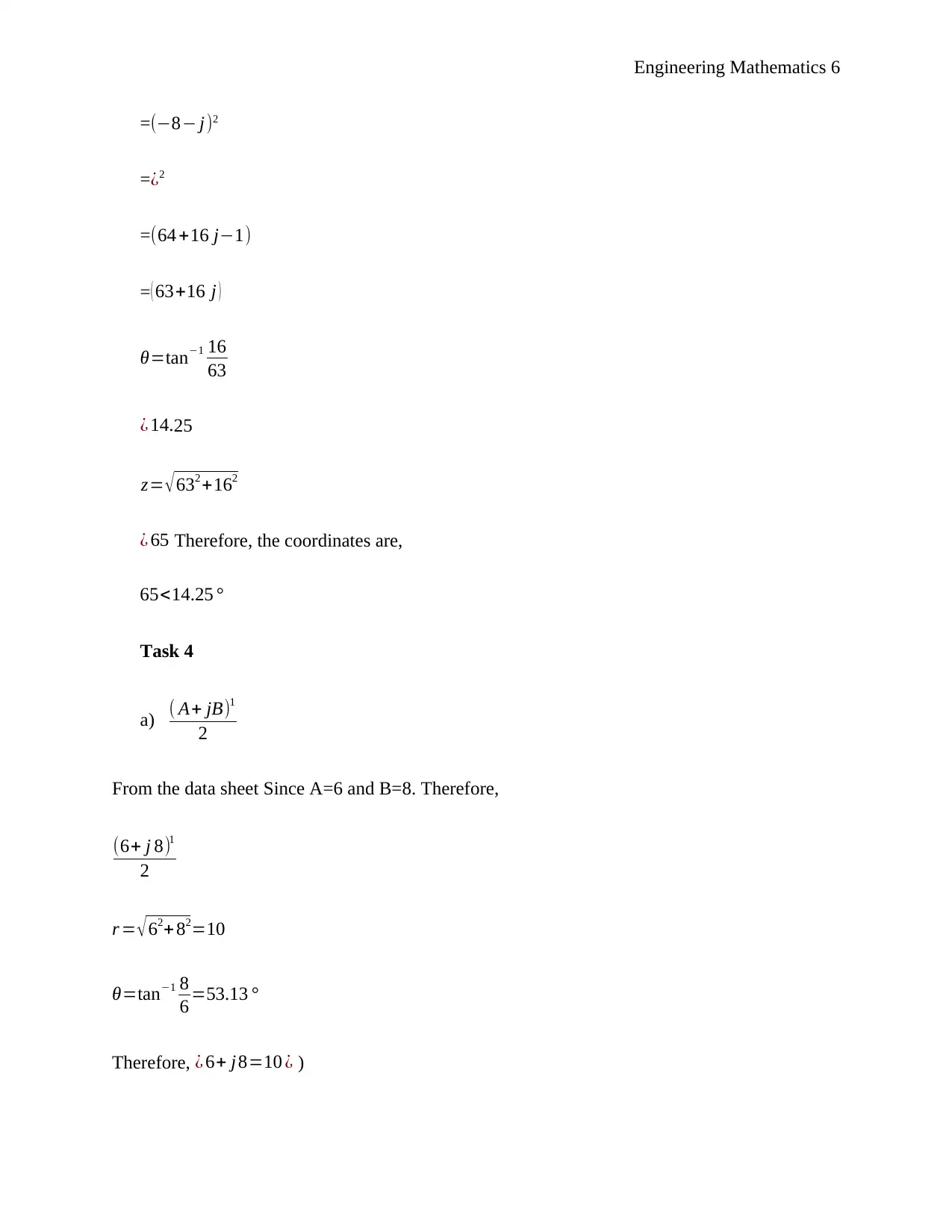
Engineering Mathematics 6
=(−8− j)2
=¿2
=(64 +16 j−1)
=( 63+16 j )
θ=tan−1 16
63
¿ 14.25
z= √632 +162
¿ 65 Therefore, the coordinates are,
65<14.25 °
Task 4
a) ( A+ jB)1
2
From the data sheet Since A=6 and B=8. Therefore,
(6+ j 8)1
2
r = √ 62+82=10
θ=tan−1 8
6 =53.13 °
Therefore, ¿ 6+ j8=10 ¿ )
=(−8− j)2
=¿2
=(64 +16 j−1)
=( 63+16 j )
θ=tan−1 16
63
¿ 14.25
z= √632 +162
¿ 65 Therefore, the coordinates are,
65<14.25 °
Task 4
a) ( A+ jB)1
2
From the data sheet Since A=6 and B=8. Therefore,
(6+ j 8)1
2
r = √ 62+82=10
θ=tan−1 8
6 =53.13 °
Therefore, ¿ 6+ j8=10 ¿ )
⊘ This is a preview!⊘
Do you want full access?
Subscribe today to unlock all pages.

Trusted by 1+ million students worldwide
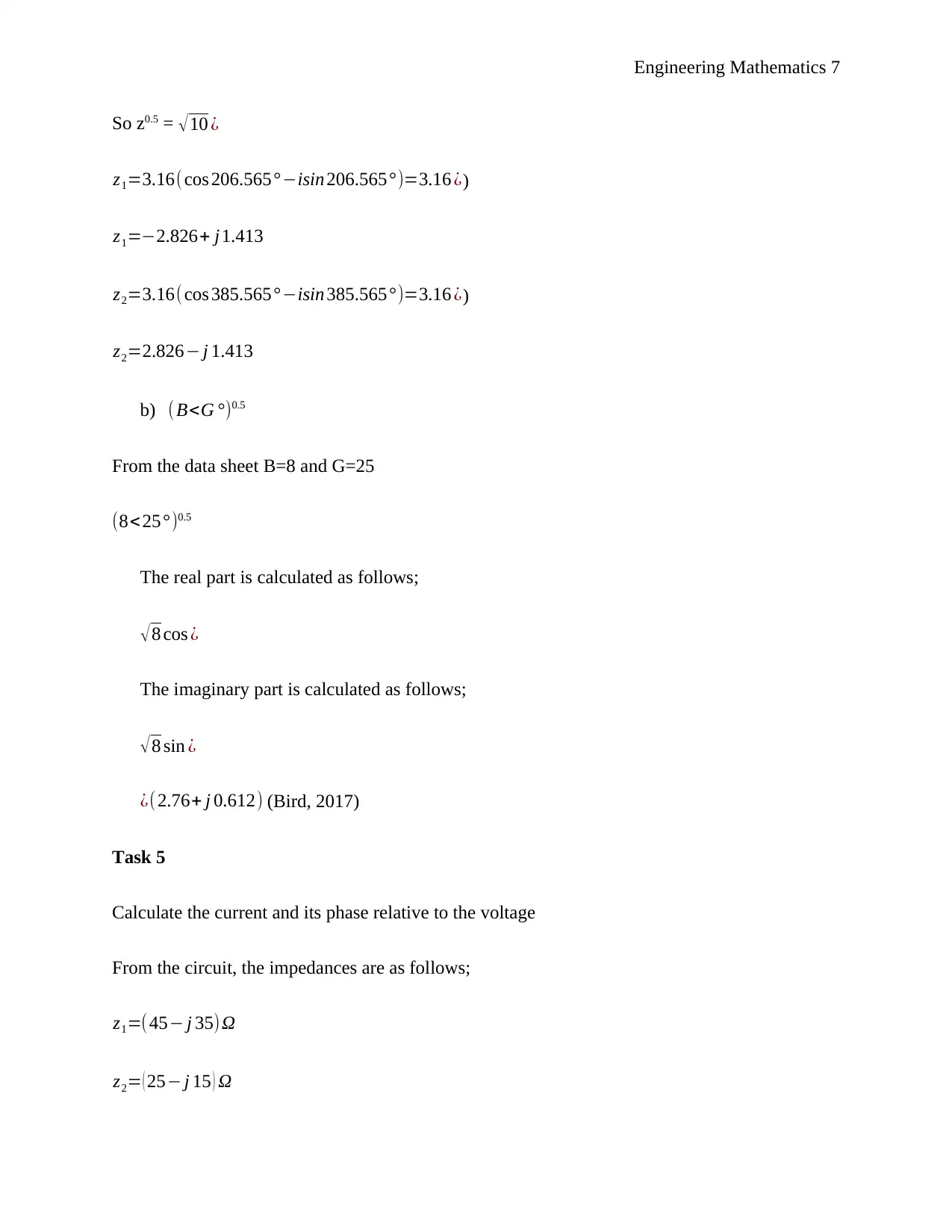
Engineering Mathematics 7
So z0.5 = √ 10 ¿
z1=3.16( cos 206.565° −isin 206.565°)=3.16 ¿)
z1=−2.826+ j1.413
z2=3.16( cos 385.565° −isin 385.565°)=3.16 ¿)
z2=2.826− j 1.413
b) (B<G °)0.5
From the data sheet B=8 and G=25
(8<25°)0.5
The real part is calculated as follows;
√8 cos ¿
The imaginary part is calculated as follows;
√ 8 sin ¿
¿( 2.76+ j 0.612) (Bird, 2017)
Task 5
Calculate the current and its phase relative to the voltage
From the circuit, the impedances are as follows;
z1=(45− j 35) Ω
z2= ( 25− j 15 ) Ω
So z0.5 = √ 10 ¿
z1=3.16( cos 206.565° −isin 206.565°)=3.16 ¿)
z1=−2.826+ j1.413
z2=3.16( cos 385.565° −isin 385.565°)=3.16 ¿)
z2=2.826− j 1.413
b) (B<G °)0.5
From the data sheet B=8 and G=25
(8<25°)0.5
The real part is calculated as follows;
√8 cos ¿
The imaginary part is calculated as follows;
√ 8 sin ¿
¿( 2.76+ j 0.612) (Bird, 2017)
Task 5
Calculate the current and its phase relative to the voltage
From the circuit, the impedances are as follows;
z1=(45− j 35) Ω
z2= ( 25− j 15 ) Ω
Paraphrase This Document
Need a fresh take? Get an instant paraphrase of this document with our AI Paraphraser
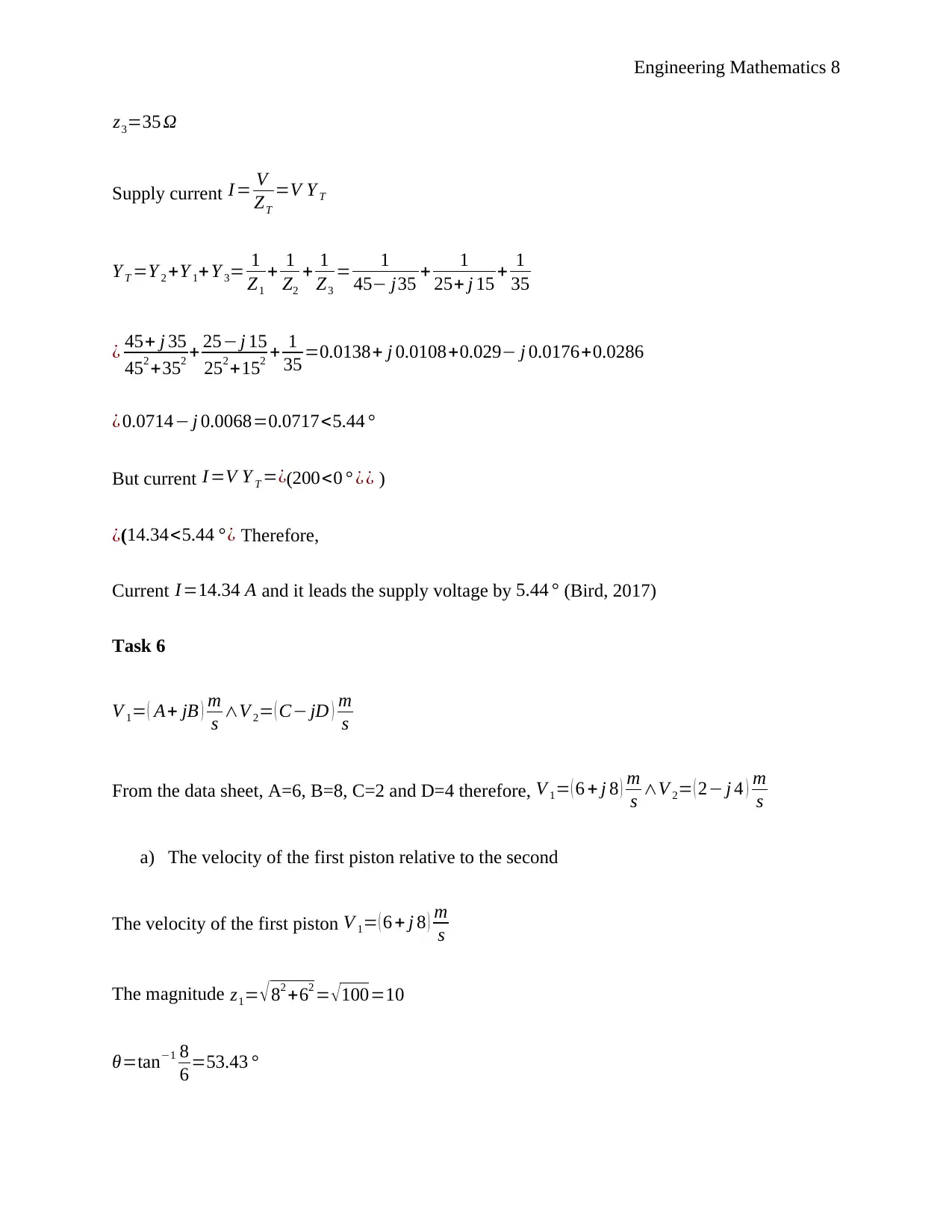
Engineering Mathematics 8
z3=35 Ω
Supply current I = V
ZT
=V Y T
Y T =Y 2 +Y 1+ Y 3= 1
Z1
+ 1
Z2
+ 1
Z3
= 1
45− j35 + 1
25+ j 15 + 1
35
¿ 45+ j 35
452 +352 + 25− j 15
252 +152 + 1
35 =0.0138+ j 0.0108+0.029− j 0.0176+0.0286
¿ 0.0714− j 0.0068=0.0717<5.44 °
But current I =V Y T =¿(200<0 ° ¿ ¿ )
¿(14.34<5.44 ° ¿ Therefore,
Current I=14.34 A and it leads the supply voltage by 5.44 ° (Bird, 2017)
Task 6
V 1= ( A+ jB ) m
s ∧V 2= ( C− jD ) m
s
From the data sheet, A=6, B=8, C=2 and D=4 therefore, V 1= ( 6 + j 8 ) m
s ∧V 2= ( 2− j 4 ) m
s
a) The velocity of the first piston relative to the second
The velocity of the first piston V 1= ( 6 + j 8 ) m
s
The magnitude z1= √ 82 +62 = √ 100=10
θ=tan−1 8
6 =53.43 °
z3=35 Ω
Supply current I = V
ZT
=V Y T
Y T =Y 2 +Y 1+ Y 3= 1
Z1
+ 1
Z2
+ 1
Z3
= 1
45− j35 + 1
25+ j 15 + 1
35
¿ 45+ j 35
452 +352 + 25− j 15
252 +152 + 1
35 =0.0138+ j 0.0108+0.029− j 0.0176+0.0286
¿ 0.0714− j 0.0068=0.0717<5.44 °
But current I =V Y T =¿(200<0 ° ¿ ¿ )
¿(14.34<5.44 ° ¿ Therefore,
Current I=14.34 A and it leads the supply voltage by 5.44 ° (Bird, 2017)
Task 6
V 1= ( A+ jB ) m
s ∧V 2= ( C− jD ) m
s
From the data sheet, A=6, B=8, C=2 and D=4 therefore, V 1= ( 6 + j 8 ) m
s ∧V 2= ( 2− j 4 ) m
s
a) The velocity of the first piston relative to the second
The velocity of the first piston V 1= ( 6 + j 8 ) m
s
The magnitude z1= √ 82 +62 = √ 100=10
θ=tan−1 8
6 =53.43 °
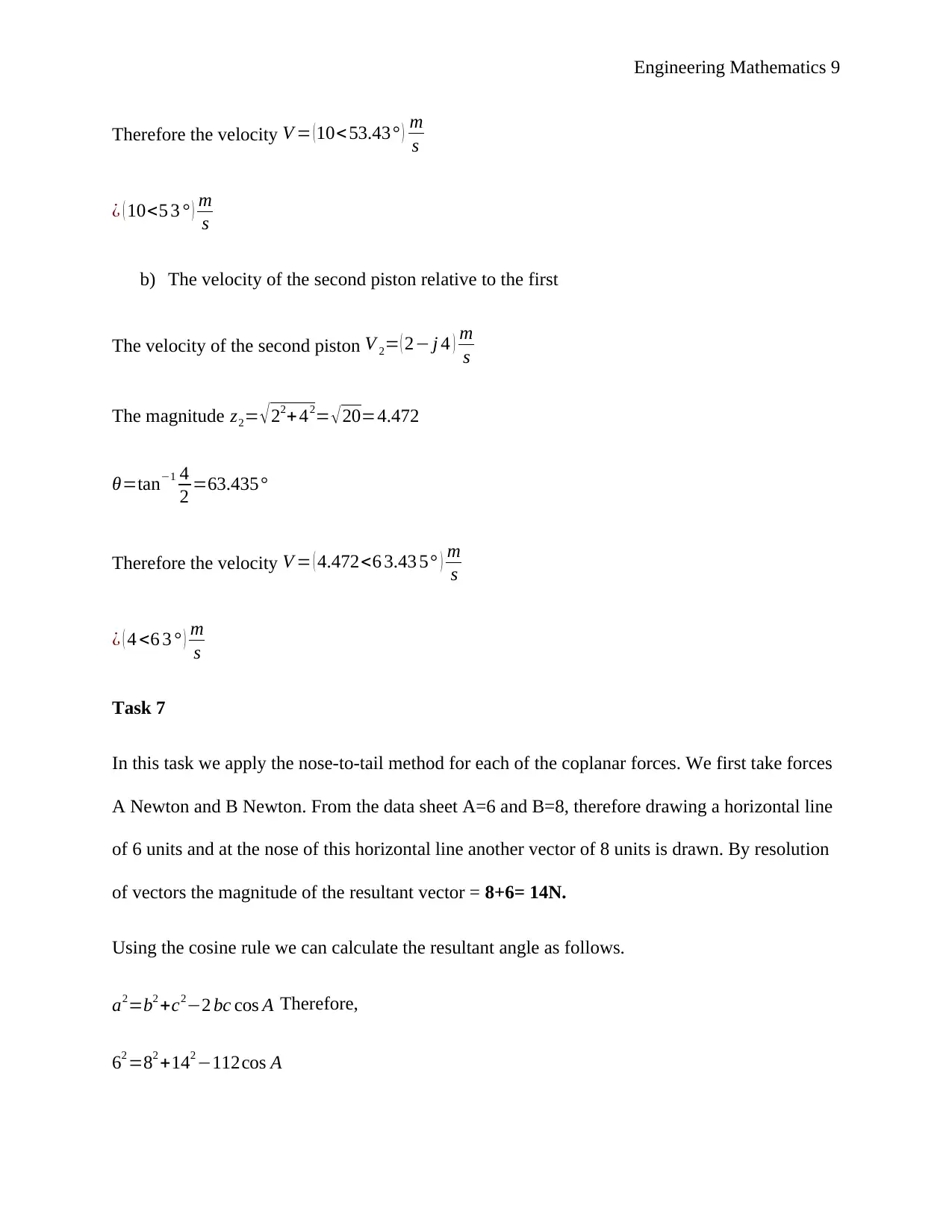
Engineering Mathematics 9
Therefore the velocity V = (10<53.43° ) m
s
¿ ( 10<5 3 ° ) m
s
b) The velocity of the second piston relative to the first
The velocity of the second piston V 2= ( 2− j 4 ) m
s
The magnitude z2= √ 22+ 42= √ 20=4.472
θ=tan−1 4
2 =63.435°
Therefore the velocity V = ( 4.472<6 3.43 5° ) m
s
¿ ( 4 <6 3 ° ) m
s
Task 7
In this task we apply the nose-to-tail method for each of the coplanar forces. We first take forces
A Newton and B Newton. From the data sheet A=6 and B=8, therefore drawing a horizontal line
of 6 units and at the nose of this horizontal line another vector of 8 units is drawn. By resolution
of vectors the magnitude of the resultant vector = 8+6= 14N.
Using the cosine rule we can calculate the resultant angle as follows.
a2=b2 +c2−2 bc cos A Therefore,
62 =82 +142 −112cos A
Therefore the velocity V = (10<53.43° ) m
s
¿ ( 10<5 3 ° ) m
s
b) The velocity of the second piston relative to the first
The velocity of the second piston V 2= ( 2− j 4 ) m
s
The magnitude z2= √ 22+ 42= √ 20=4.472
θ=tan−1 4
2 =63.435°
Therefore the velocity V = ( 4.472<6 3.43 5° ) m
s
¿ ( 4 <6 3 ° ) m
s
Task 7
In this task we apply the nose-to-tail method for each of the coplanar forces. We first take forces
A Newton and B Newton. From the data sheet A=6 and B=8, therefore drawing a horizontal line
of 6 units and at the nose of this horizontal line another vector of 8 units is drawn. By resolution
of vectors the magnitude of the resultant vector = 8+6= 14N.
Using the cosine rule we can calculate the resultant angle as follows.
a2=b2 +c2−2 bc cos A Therefore,
62 =82 +142 −112cos A
⊘ This is a preview!⊘
Do you want full access?
Subscribe today to unlock all pages.

Trusted by 1+ million students worldwide
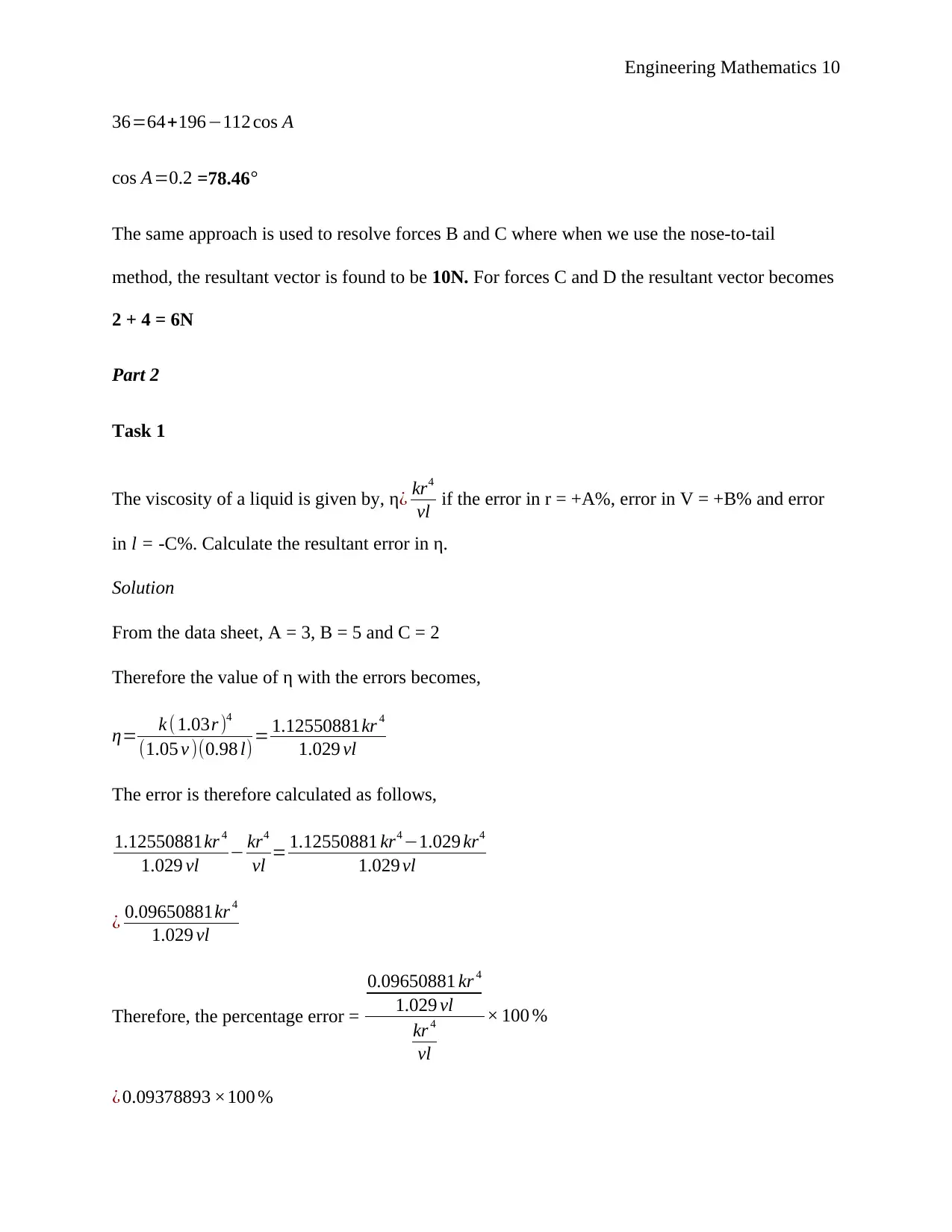
Engineering Mathematics 10
36=64+196−112 cos A
cos A=0.2 =78.46°
The same approach is used to resolve forces B and C where when we use the nose-to-tail
method, the resultant vector is found to be 10N. For forces C and D the resultant vector becomes
2 + 4 = 6N
Part 2
Task 1
The viscosity of a liquid is given by, η ¿ kr4
vl if the error in r = +A%, error in V = +B% and error
in l = -C%. Calculate the resultant error in η.
Solution
From the data sheet, A = 3, B = 5 and C = 2
Therefore the value of η with the errors becomes,
η= k ( 1.03r )4
(1.05 v )(0.98 l)= 1.12550881kr 4
1.029 vl
The error is therefore calculated as follows,
1.12550881kr 4
1.029 vl − kr4
vl = 1.12550881 kr4 −1.029 kr4
1.029 vl
¿ 0.09650881kr 4
1.029 vl
Therefore, the percentage error =
0.09650881 kr 4
1.029 vl
kr 4
vl
× 100 %
¿ 0.09378893 ×100 %
36=64+196−112 cos A
cos A=0.2 =78.46°
The same approach is used to resolve forces B and C where when we use the nose-to-tail
method, the resultant vector is found to be 10N. For forces C and D the resultant vector becomes
2 + 4 = 6N
Part 2
Task 1
The viscosity of a liquid is given by, η ¿ kr4
vl if the error in r = +A%, error in V = +B% and error
in l = -C%. Calculate the resultant error in η.
Solution
From the data sheet, A = 3, B = 5 and C = 2
Therefore the value of η with the errors becomes,
η= k ( 1.03r )4
(1.05 v )(0.98 l)= 1.12550881kr 4
1.029 vl
The error is therefore calculated as follows,
1.12550881kr 4
1.029 vl − kr4
vl = 1.12550881 kr4 −1.029 kr4
1.029 vl
¿ 0.09650881kr 4
1.029 vl
Therefore, the percentage error =
0.09650881 kr 4
1.029 vl
kr 4
vl
× 100 %
¿ 0.09378893 ×100 %
Paraphrase This Document
Need a fresh take? Get an instant paraphrase of this document with our AI Paraphraser
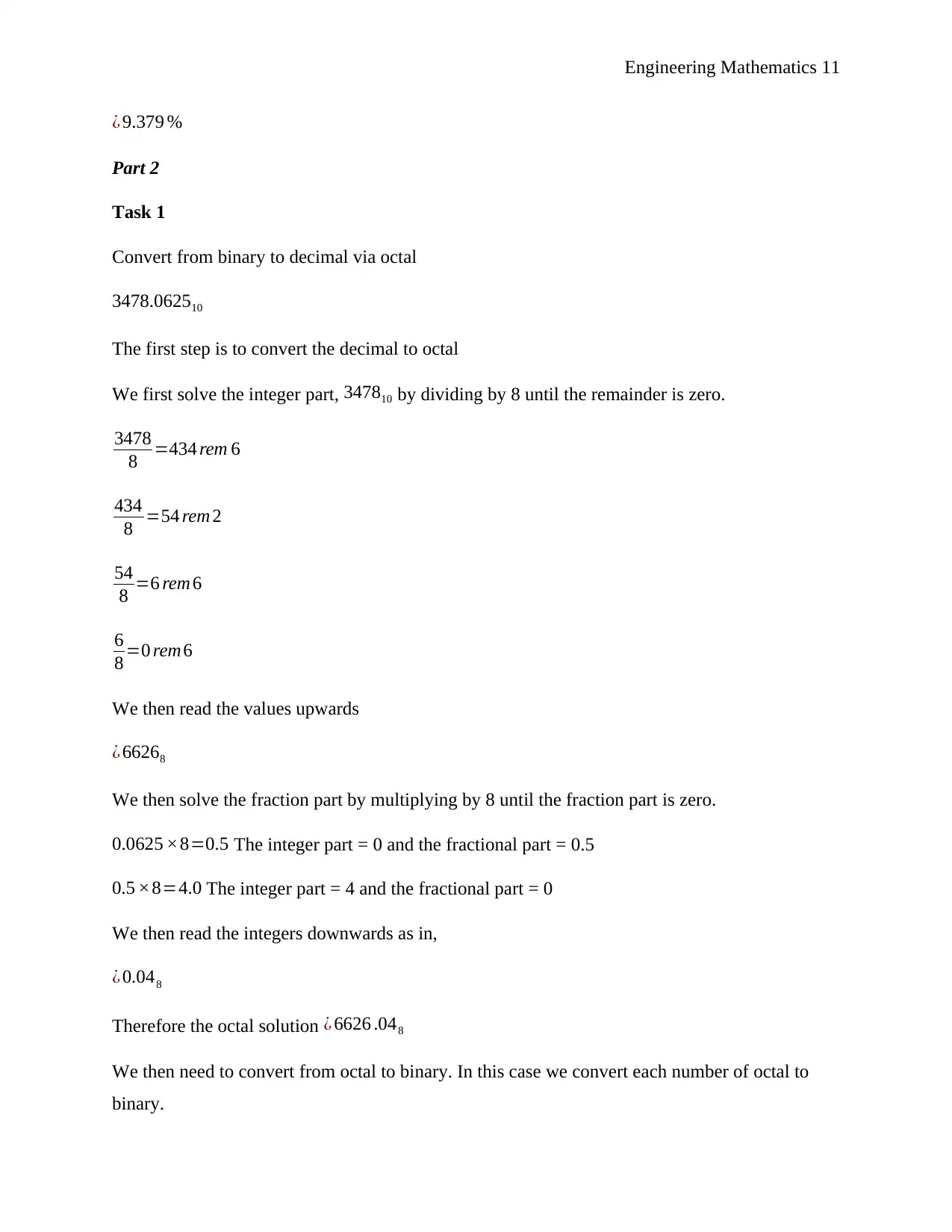
Engineering Mathematics 11
¿ 9.379 %
Part 2
Task 1
Convert from binary to decimal via octal
3478.062510
The first step is to convert the decimal to octal
We first solve the integer part, 347810 by dividing by 8 until the remainder is zero.
3478
8 =434 rem 6
434
8 =54 rem 2
54
8 =6 rem 6
6
8 =0 rem 6
We then read the values upwards
¿ 66268
We then solve the fraction part by multiplying by 8 until the fraction part is zero.
0.0625 ×8=0.5 The integer part = 0 and the fractional part = 0.5
0.5 ×8=4.0 The integer part = 4 and the fractional part = 0
We then read the integers downwards as in,
¿ 0.048
Therefore the octal solution ¿ 6626 .048
We then need to convert from octal to binary. In this case we convert each number of octal to
binary.
¿ 9.379 %
Part 2
Task 1
Convert from binary to decimal via octal
3478.062510
The first step is to convert the decimal to octal
We first solve the integer part, 347810 by dividing by 8 until the remainder is zero.
3478
8 =434 rem 6
434
8 =54 rem 2
54
8 =6 rem 6
6
8 =0 rem 6
We then read the values upwards
¿ 66268
We then solve the fraction part by multiplying by 8 until the fraction part is zero.
0.0625 ×8=0.5 The integer part = 0 and the fractional part = 0.5
0.5 ×8=4.0 The integer part = 4 and the fractional part = 0
We then read the integers downwards as in,
¿ 0.048
Therefore the octal solution ¿ 6626 .048
We then need to convert from octal to binary. In this case we convert each number of octal to
binary.
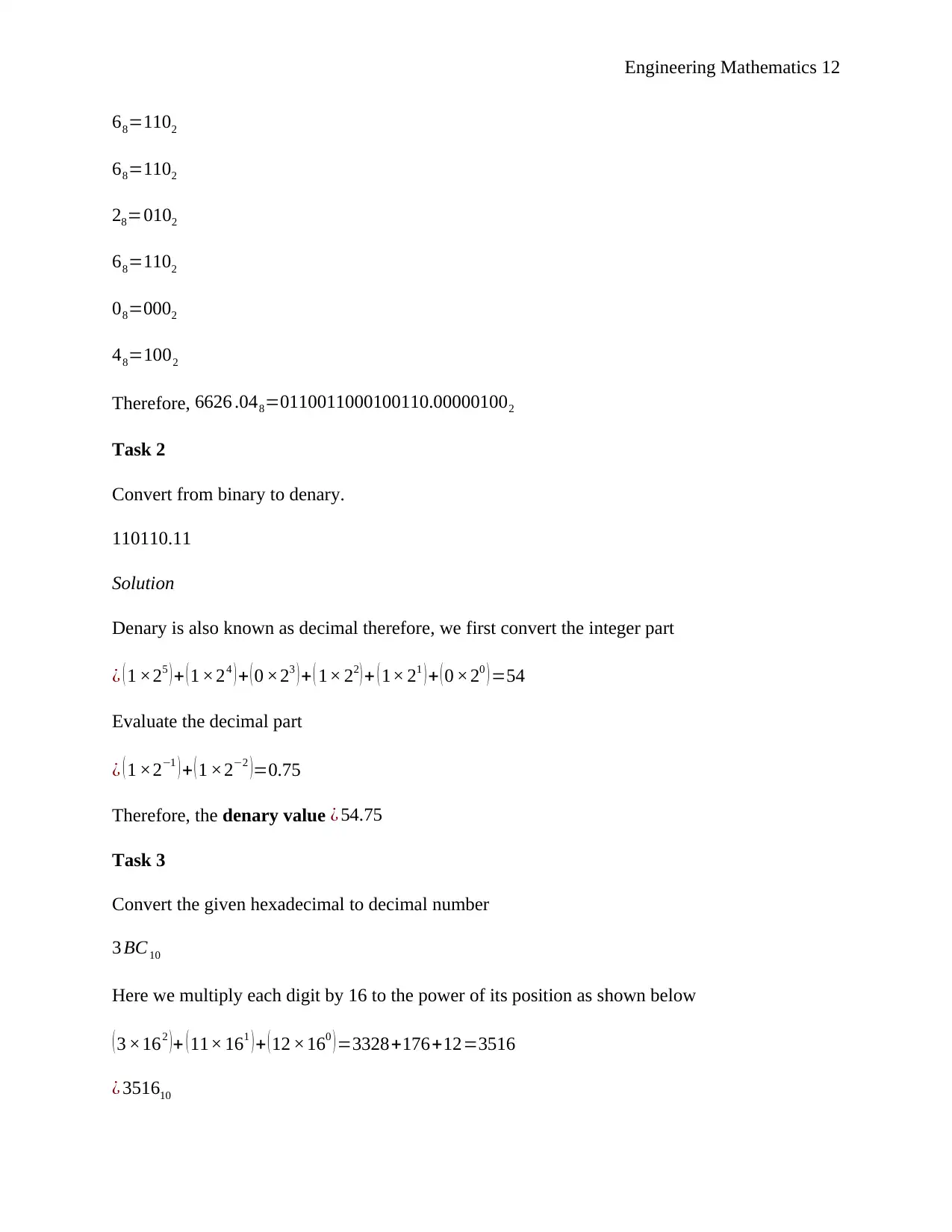
Engineering Mathematics 12
68=1102
68=1102
28=0102
68=1102
08=0002
48=1002
Therefore, 6626 .048=0110011000100110.000001002
Task 2
Convert from binary to denary.
110110.11
Solution
Denary is also known as decimal therefore, we first convert the integer part
¿ ( 1 ×25 ) + ( 1 ×24 ) + ( 0 ×23 ) + ( 1× 22 ) + ( 1× 21 ) + ( 0 ×20 ) =54
Evaluate the decimal part
¿ ( 1 ×2−1 ) + ( 1 ×2−2 )=0.75
Therefore, the denary value ¿ 54.75
Task 3
Convert the given hexadecimal to decimal number
3 BC10
Here we multiply each digit by 16 to the power of its position as shown below
( 3 ×162 )+ ( 11× 161 )+ ( 12 ×160 )=3328+176+12=3516
¿ 351610
68=1102
68=1102
28=0102
68=1102
08=0002
48=1002
Therefore, 6626 .048=0110011000100110.000001002
Task 2
Convert from binary to denary.
110110.11
Solution
Denary is also known as decimal therefore, we first convert the integer part
¿ ( 1 ×25 ) + ( 1 ×24 ) + ( 0 ×23 ) + ( 1× 22 ) + ( 1× 21 ) + ( 0 ×20 ) =54
Evaluate the decimal part
¿ ( 1 ×2−1 ) + ( 1 ×2−2 )=0.75
Therefore, the denary value ¿ 54.75
Task 3
Convert the given hexadecimal to decimal number
3 BC10
Here we multiply each digit by 16 to the power of its position as shown below
( 3 ×162 )+ ( 11× 161 )+ ( 12 ×160 )=3328+176+12=3516
¿ 351610
⊘ This is a preview!⊘
Do you want full access?
Subscribe today to unlock all pages.

Trusted by 1+ million students worldwide
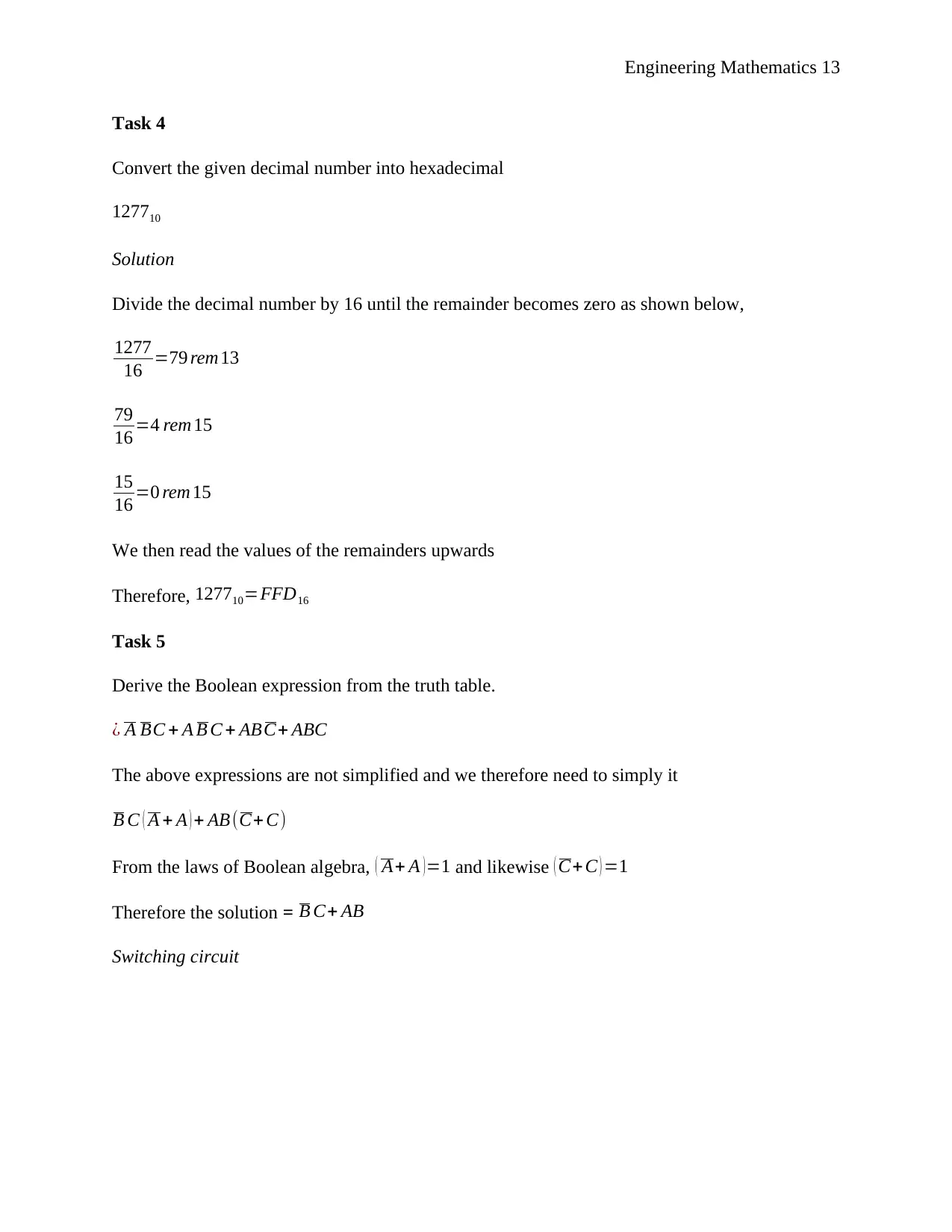
Engineering Mathematics 13
Task 4
Convert the given decimal number into hexadecimal
127710
Solution
Divide the decimal number by 16 until the remainder becomes zero as shown below,
1277
16 =79 rem 13
79
16 =4 rem 15
15
16 =0 rem 15
We then read the values of the remainders upwards
Therefore, 127710=FFD16
Task 5
Derive the Boolean expression from the truth table.
¿ A BC + A B C + ABC+ ABC
The above expressions are not simplified and we therefore need to simply it
B C ( A + A ) + AB(C+ C)
From the laws of Boolean algebra, ( A+ A ) =1 and likewise ( C+C ) =1
Therefore the solution = B C+ AB
Switching circuit
Task 4
Convert the given decimal number into hexadecimal
127710
Solution
Divide the decimal number by 16 until the remainder becomes zero as shown below,
1277
16 =79 rem 13
79
16 =4 rem 15
15
16 =0 rem 15
We then read the values of the remainders upwards
Therefore, 127710=FFD16
Task 5
Derive the Boolean expression from the truth table.
¿ A BC + A B C + ABC+ ABC
The above expressions are not simplified and we therefore need to simply it
B C ( A + A ) + AB(C+ C)
From the laws of Boolean algebra, ( A+ A ) =1 and likewise ( C+C ) =1
Therefore the solution = B C+ AB
Switching circuit
Paraphrase This Document
Need a fresh take? Get an instant paraphrase of this document with our AI Paraphraser
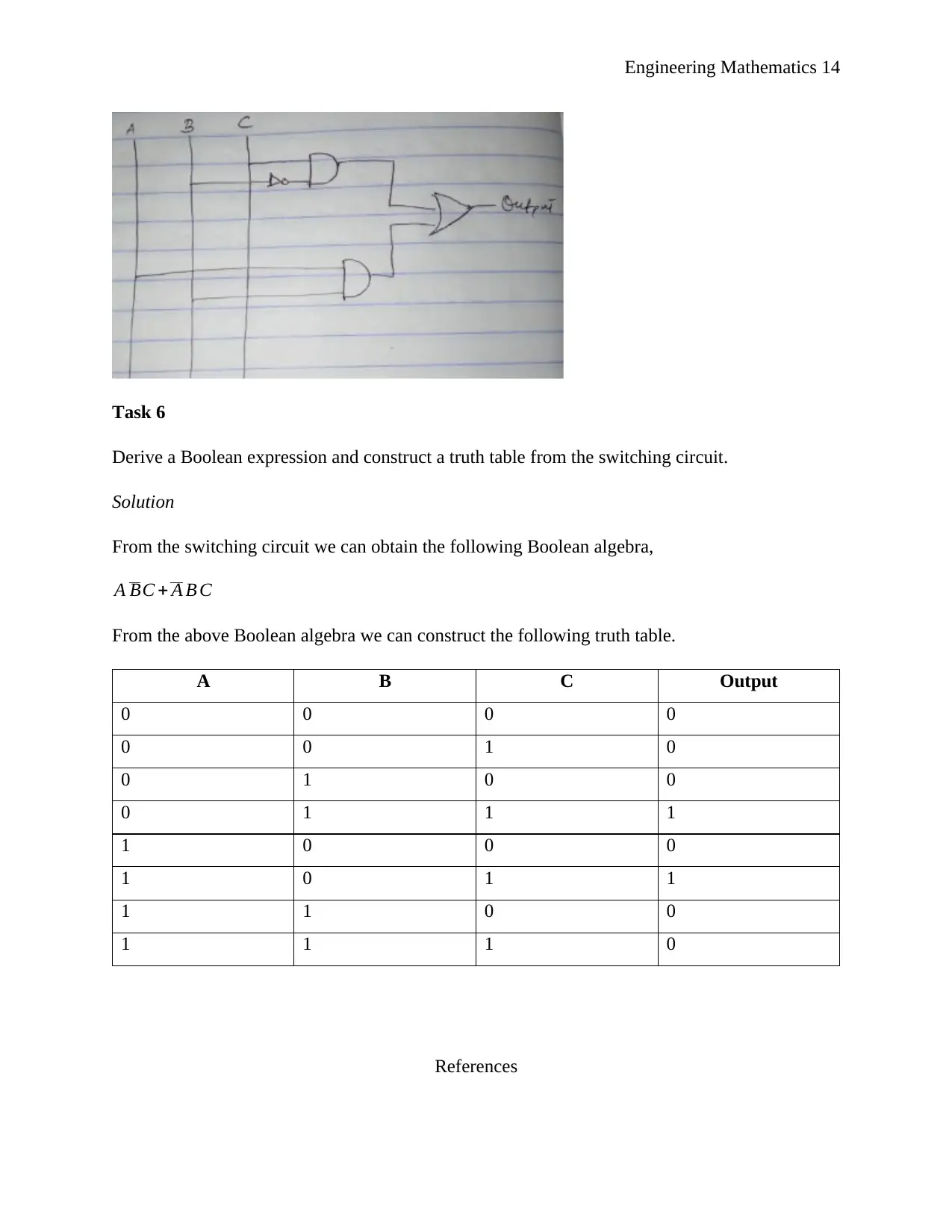
Engineering Mathematics 14
Task 6
Derive a Boolean expression and construct a truth table from the switching circuit.
Solution
From the switching circuit we can obtain the following Boolean algebra,
A BC + A B C
From the above Boolean algebra we can construct the following truth table.
A B C Output
0 0 0 0
0 0 1 0
0 1 0 0
0 1 1 1
1 0 0 0
1 0 1 1
1 1 0 0
1 1 1 0
References
Task 6
Derive a Boolean expression and construct a truth table from the switching circuit.
Solution
From the switching circuit we can obtain the following Boolean algebra,
A BC + A B C
From the above Boolean algebra we can construct the following truth table.
A B C Output
0 0 0 0
0 0 1 0
0 1 0 0
0 1 1 1
1 0 0 0
1 0 1 1
1 1 0 0
1 1 1 0
References
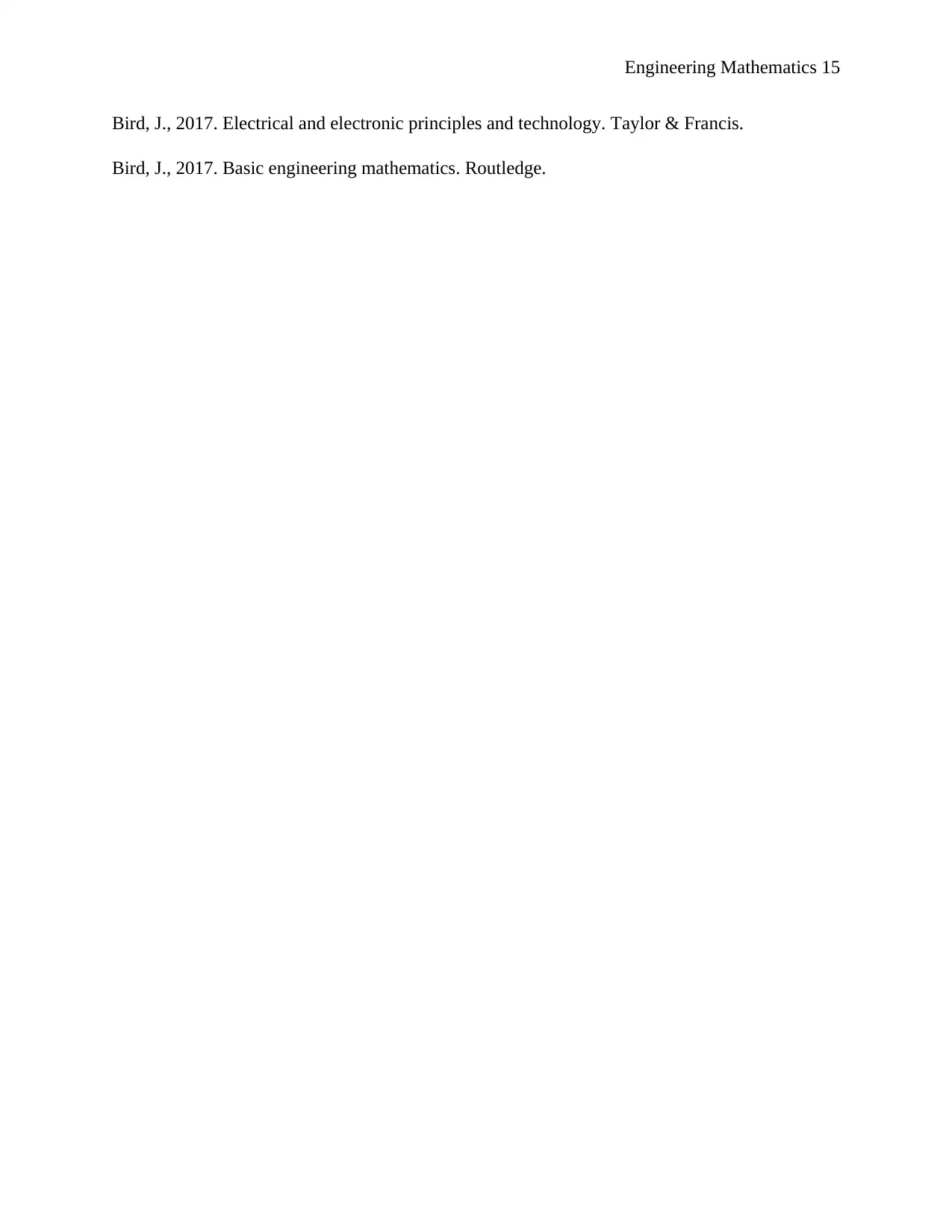
Engineering Mathematics 15
Bird, J., 2017. Electrical and electronic principles and technology. Taylor & Francis.
Bird, J., 2017. Basic engineering mathematics. Routledge.
Bird, J., 2017. Electrical and electronic principles and technology. Taylor & Francis.
Bird, J., 2017. Basic engineering mathematics. Routledge.
⊘ This is a preview!⊘
Do you want full access?
Subscribe today to unlock all pages.

Trusted by 1+ million students worldwide
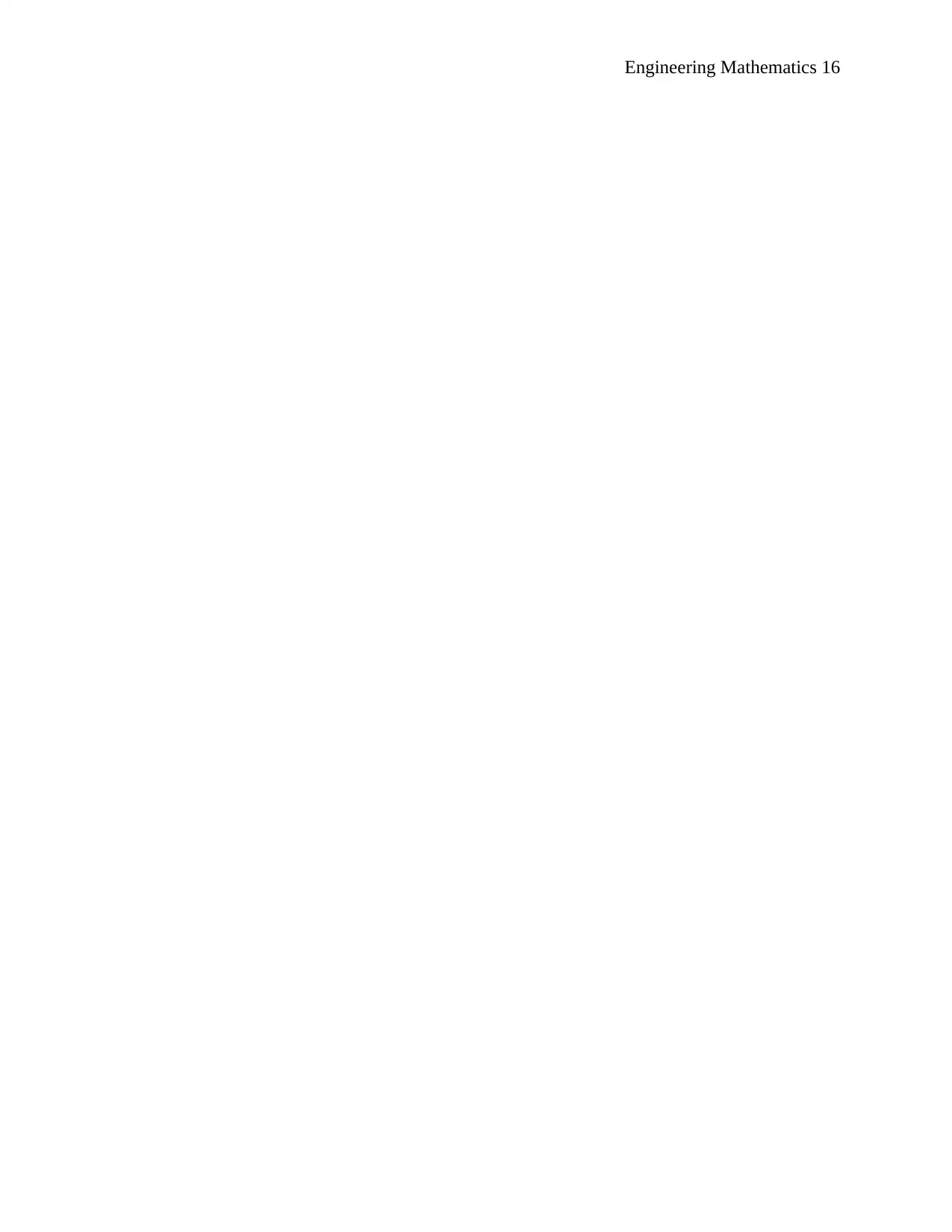
Engineering Mathematics 16
1 out of 16
Your All-in-One AI-Powered Toolkit for Academic Success.
+13062052269
info@desklib.com
Available 24*7 on WhatsApp / Email
![[object Object]](/_next/static/media/star-bottom.7253800d.svg)
Unlock your academic potential
© 2024 | Zucol Services PVT LTD | All rights reserved.
